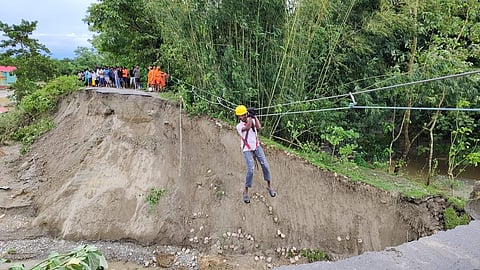

Extremely heavy and relentless rainfall from October 4 evening till the morning of October 5, has caused a flood-like situation in northern West Bengal besides triggering numerous landslides in Darjeeling and its adjoining areas.
Seventeen people were reported dead till the afternoon of October 5. The Gorkhaland Territorial Administration (GTA) has announced the closure of all tourist spots until further notice to ensure safety of visitors.
Darjeeling, Jalpaiguri, Kalimpong and Alipurduar districts have been impacted the most in the north Bengal region.
The state of Sikkim has been largely cut off as National Highway 10 is currently blocked. Several roads in most of the state’s districts are currently closed because of landslides, apart from capital Gangtok. These include those connecting Sikkim with West Bengal, according to a notice issued by Sikkim Police on October 5, accessed by this correspondent.
The India Meteorological Department (IMD) had earlier predicted heavy to very heavy rainfall from October 4 afternoon. It confirmed on October 5 noon that several places in Jalpaiguri received 370 millimetres of rain on October 4 till October 5 morning. Darjeeling received 270 millimetres. The IMD issued a Red warning for a few places for October 5. The agency predicted further rain during the next few days.
“Heavy rain (70 to 200 mm) is expected at a few places, with extremely heavy rainfall of more than 200 mm over Coochbehar and Alipurduar districts. Heavy to very heavy (70 to 200 mm) rain is likely to occur over Darjeeling, Kalimpong and Jalpaiguri districts,” pointed out Habibur Rahaman Biswas, head of the IMD’s regional meteorological centre in Kolkata.
There is an apprehension of further deterioration as Bhutan’s Tala hydropower dam started to overflow on October 5 morning, raising the risk of more flooding in north Bengal.
According to information shared by the Bhutan government with West Bengal authorities, and accessed by this correspondent, “… the Tala Dam in western Bhutan was overtopped due to a sudden and dramatic surge in the Wangchhu river’s flow, triggered by intense and unprecedented rainfall in the region … the river inflow rose sharply from under 200 cubic meters per second (cumecs) at 4.00 am to approximately 1,260 cumecs by 11.00 am”. It further said “the buildup of water behind the dam led to overtopping around 7.00 am…”.
According to a senior state government official from Nabanna (West Bengal state secretariat), the National Disaster Response Force (NDRF) has already put out the “highest alert level” for Alipurduar.
A senior official from the north Bengal administration confirmed that there have been close to a hundred landslides in Darjeeling and adjoining Kalimpong, including 35 major ones, damaging and blocking several roads. As of October 5 afternoon, NH 10 and Rohini Road connecting Darjeeling with Siliguri are closed, with Sikkim largely cut off.
According to Raj Basu, ecotourism chairman of the West Bengal government, tourists from other parts of the country are safe for now. Efforts are on to evacuate those having immediate train or flight connections through Pankhabari Road. Basu said close to 130 tourist associations have been working hand-in-hand with the local administrations of four districts to ensure maximum safety of tourists.
However, despite all efforts, tourists have been stranded in several places due to road blockages and landslides, local sources said. “The wooden bridge on the Holong river has collapsed in Jalpaiguri and a few hundred tourists have been held up in the Madarihat tourist lodge,” pointed out a local.
“Apart from the natural calamity, the completely unplanned urbanisation in Darjeeling and adjoining mountainous areas, often closing down jhoras (local water outlets), is the major reason behind this state of affairs,” alleged an environmentalist.
On October 5, Prime Minister Narendra Modi expressed grief at the loss of life and pointed out in his X post that “authorities are closely monitoring the situation in Darjeeling and surrounding areas affected by heavy rainfall and landslides.”
West Bengal Chief Minister Mamata Banerjee will be rushing to north Bengal on October 6 to take stock of the situation. Already, under her instruction, a high-power committee has been formed to look after the critical condition of north Bengal. Banerjee advised tourists not to venture out and stay put for the time being.
Bengal’s irrigation minister, who also referred to the Tala dam spill, blamed the Union government for the situation in north Bengal. “The situation is very serious. Sustained rainfall over a long period has caused the water level to rise in most rivers of the region. Since 2011, we have repeatedly urged the central government to take initiative to form the Indo-Bhutan River Commission and find a sustainable solution to this annual menace. But they never paid any attention,” alleged Manas Bhuniya, the state irrigation minister to this correspondent. He also flagged the issue of downstream flooding caused by Sikkim’s dam projects and the lack of central support for disaster management since 2016.
According to the minister, nearly 72 major rivers and streams enter north Bengal from Bhutan. These bring enormous amounts of water into north Bengal districts from upstream, causing floods.
“It is nothing new. But, in recent years, the situation has worsened. Incidences of short, quick bursts of heavy rainfall episodes increased due to the changing climate. This, coupled with rising siltation of most rivers, reduced their capacity to hold water,” said environmentalist Animesh Basu from Siliguri.